Items
Spatial Coverage is exactly
Devon
-
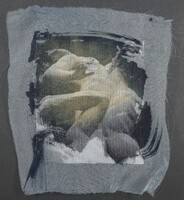 Abduction
Double-layered cyanotype photographs toned with tea on cotton; toned cyanotype on silk Abduction We agreed that lover’s locks left on bridges were a plague on good taste, but there we were: happy-tipsy on Florence’s Ponte Vecchio. We thought it a laugh when I pulled the small padlock from my camera bag. You borrowed a waterproof black marker from another couple. We squeezed our lock in with hundreds of others beneath the statue of sculptor Benvenuto Cellini. Off the bridge, we rounded the corner, hand in hand. We stopped. There was Cellini’s sculpture of a smug Perseus, sword in one hand, the bloody head of the snake-haired Medusa in the other. There was Giambologna’s sculpture of a woman struggling in her abductor’s arms. Lovers, smug in their bright cocoon, are blind to irony.
Abduction
Double-layered cyanotype photographs toned with tea on cotton; toned cyanotype on silk Abduction We agreed that lover’s locks left on bridges were a plague on good taste, but there we were: happy-tipsy on Florence’s Ponte Vecchio. We thought it a laugh when I pulled the small padlock from my camera bag. You borrowed a waterproof black marker from another couple. We squeezed our lock in with hundreds of others beneath the statue of sculptor Benvenuto Cellini. Off the bridge, we rounded the corner, hand in hand. We stopped. There was Cellini’s sculpture of a smug Perseus, sword in one hand, the bloody head of the snake-haired Medusa in the other. There was Giambologna’s sculpture of a woman struggling in her abductor’s arms. Lovers, smug in their bright cocoon, are blind to irony. -
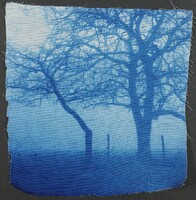 Dieback
cyanotype photograph on cotton Dieback (after e e cummings) the leaping greenly spirits of trees speak a leaf language, a susurration which is lungful, which is air, which is yes now the ears of my ears awake to the resinous hiss of the burning pine which is trial, which is fire, which is resurrection now the ears of my ears awake to the tin tremor of the aspen’s silver-bottomed leaves which is memory, which is mourning, which is melancholia now the ears of my ears awake to the window scratch of the diseased ash which is rattle, which is hum, which is future
Dieback
cyanotype photograph on cotton Dieback (after e e cummings) the leaping greenly spirits of trees speak a leaf language, a susurration which is lungful, which is air, which is yes now the ears of my ears awake to the resinous hiss of the burning pine which is trial, which is fire, which is resurrection now the ears of my ears awake to the tin tremor of the aspen’s silver-bottomed leaves which is memory, which is mourning, which is melancholia now the ears of my ears awake to the window scratch of the diseased ash which is rattle, which is hum, which is future -
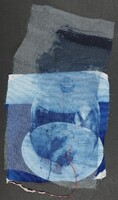 Fruitpicking
Double-layered cyanotype photographs on cotton and on silk, red embroidery thread, beeswax Fruitpicking That winter in the orchard cottage, they folded together under cobalt night and passed, in dreams, from this world to that. Then, came picking season, and things changed: One could no longer share the night’s echoes of the day’s words, could no longer tolerate the tyrannical metronome of the other’s heartbeat. One’s skin thickened, like a lemon left hanging, while the other’s grew thinner, and, like a cherry skin at the height of summer, threatened to burst into a fleshwound at the slightest touch.
Fruitpicking
Double-layered cyanotype photographs on cotton and on silk, red embroidery thread, beeswax Fruitpicking That winter in the orchard cottage, they folded together under cobalt night and passed, in dreams, from this world to that. Then, came picking season, and things changed: One could no longer share the night’s echoes of the day’s words, could no longer tolerate the tyrannical metronome of the other’s heartbeat. One’s skin thickened, like a lemon left hanging, while the other’s grew thinner, and, like a cherry skin at the height of summer, threatened to burst into a fleshwound at the slightest touch. -
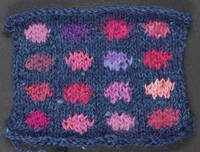 Patch by Ann
What an interesting project! I liked making things from a very young age and years on. My mother let me be in charge of Christmas decorations etc and in a craft shop she would buy anything I thought I might need. - She would knit all the vests and tops and shorts for me my sister and my three brothers - usually all in the same colour so she could spot us all on the beach... - Then the family fortunes changed and she had to go out to work so I took on the job to knit for the family. I used to persuade a brother to walk in front of me so that I could knit as we walked along - we lived in the country 2 1/2 miles from school. - In my teens I knitted a very complicated jacket for my Mother as a Christmas present - a collar with a mitered edge and inset pockets! At teacher training college I realised you could knit schulptural things. I knitted pillars and boats and lamp shades and fun designs to frame and put on the wall - houses and views etc and then on to abstracts first enjoying the colours and textures. This little sample includes mixed yarns or dyed yarns including wool, mohair, cotton, metalised (wrong word) and acrilic based on an original design of wool shop shelves where the wool is stored for sale. That design was a silk painting of squares in outline and many shades of the same colours in each square - mine actually and from there just circles floating...
Patch by Ann
What an interesting project! I liked making things from a very young age and years on. My mother let me be in charge of Christmas decorations etc and in a craft shop she would buy anything I thought I might need. - She would knit all the vests and tops and shorts for me my sister and my three brothers - usually all in the same colour so she could spot us all on the beach... - Then the family fortunes changed and she had to go out to work so I took on the job to knit for the family. I used to persuade a brother to walk in front of me so that I could knit as we walked along - we lived in the country 2 1/2 miles from school. - In my teens I knitted a very complicated jacket for my Mother as a Christmas present - a collar with a mitered edge and inset pockets! At teacher training college I realised you could knit schulptural things. I knitted pillars and boats and lamp shades and fun designs to frame and put on the wall - houses and views etc and then on to abstracts first enjoying the colours and textures. This little sample includes mixed yarns or dyed yarns including wool, mohair, cotton, metalised (wrong word) and acrilic based on an original design of wool shop shelves where the wool is stored for sale. That design was a silk painting of squares in outline and many shades of the same colours in each square - mine actually and from there just circles floating... -
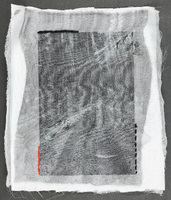 Patch by Corinna
This multi-layered patch is made of silk, cotton, photographic transparency film, and beeswax, based on a photograph I made of a forest in Cypress Hills, Saskatchewan, Canada. In many ways, it’s an ecological battleground. Here, trembling aspen, balsam poplar, white spruce, and lodgepole pine invade the grasslands, while trees are threatened by invasive species like dwarf mistletoe. Fire destroys, yet it increases plant diversity, attracts bees, and allows the lodgepole pine to reseed by melting the resin that seals its cones. So, the forest raises questions around terms like native and invasive, parasitism and mutualism.
Patch by Corinna
This multi-layered patch is made of silk, cotton, photographic transparency film, and beeswax, based on a photograph I made of a forest in Cypress Hills, Saskatchewan, Canada. In many ways, it’s an ecological battleground. Here, trembling aspen, balsam poplar, white spruce, and lodgepole pine invade the grasslands, while trees are threatened by invasive species like dwarf mistletoe. Fire destroys, yet it increases plant diversity, attracts bees, and allows the lodgepole pine to reseed by melting the resin that seals its cones. So, the forest raises questions around terms like native and invasive, parasitism and mutualism. -
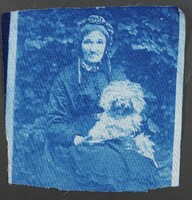 Patch by Corinna
I made a cyanotype print of this Victorian carte de viste of a woman with dog. She looked familiar, and I thought she might be a writer. An image search brought up hundreds of images of Victorian and Edwardian women and their beloved dogs, including a grainy photograph of an American writer, Louise Clarke Pyrnelle, whose dog bore some resemblance to this one. But, no, the women’s faces are too different. So, while the mystery remains, I have enjoyed seeing all the pugs, Chihuahuas, Pomeranians and mutts of all descriptions captured in photographs with their dogmoms. I once explored an abandoned grand mansion in the Scottish Highlands. The decaying house was glorious but empty, so I gathered little knowledge about its previous occupants. On my way out of the grounds, through dense woods, I stubbed my toe, hard, on a boulder at the base of a huge old oak. I crouched down, pushed aside ferns, and found a memorial to two obviously beloved dogs, Brua and Tappie, who had died together in 1932. I felt at once a connection, across time, in an unfamiliar place, with their owner, an unknown woman. Later, I researched the dog’s owner, the former mistress of the house. She was a suffragette, photographer, and a lover of dogs, especially West Highland White Terriers, a breed developed by her ancestors. I think I would have liked her.
Patch by Corinna
I made a cyanotype print of this Victorian carte de viste of a woman with dog. She looked familiar, and I thought she might be a writer. An image search brought up hundreds of images of Victorian and Edwardian women and their beloved dogs, including a grainy photograph of an American writer, Louise Clarke Pyrnelle, whose dog bore some resemblance to this one. But, no, the women’s faces are too different. So, while the mystery remains, I have enjoyed seeing all the pugs, Chihuahuas, Pomeranians and mutts of all descriptions captured in photographs with their dogmoms. I once explored an abandoned grand mansion in the Scottish Highlands. The decaying house was glorious but empty, so I gathered little knowledge about its previous occupants. On my way out of the grounds, through dense woods, I stubbed my toe, hard, on a boulder at the base of a huge old oak. I crouched down, pushed aside ferns, and found a memorial to two obviously beloved dogs, Brua and Tappie, who had died together in 1932. I felt at once a connection, across time, in an unfamiliar place, with their owner, an unknown woman. Later, I researched the dog’s owner, the former mistress of the house. She was a suffragette, photographer, and a lover of dogs, especially West Highland White Terriers, a breed developed by her ancestors. I think I would have liked her. -
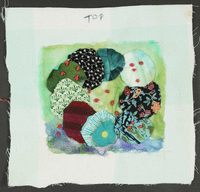 Patch by Diana
I have created a small applique patchwork to represent the connections between my 8 other sewing friends in South Devon. We meet regularly in each others houses to work on our own textile projects and sometimes work collaboratively for a larger project (eg making quilts to be used by the charity Grow for Good at their premises in Sparkwell) or learn from each other a new technique. We knit, we sew, we chat, we laugh, we sometimes cry and we always support and encourage each other. We inspire by our own work or by sharing experiences and other textiles seen around the world. My piece is constructed from scraps from a number of people, some no longer sewing or even alive. I enjoyed re-purposing even tiny 'crumbs', layering and embroidering. Little is wasted. Some seemingly insignificant scrap can find its place to lift the composition. The overlapping, continuous circles are simple and individual but sewn together they complement each other so as to become part of the bigger picture. Much as we are in life.
Patch by Diana
I have created a small applique patchwork to represent the connections between my 8 other sewing friends in South Devon. We meet regularly in each others houses to work on our own textile projects and sometimes work collaboratively for a larger project (eg making quilts to be used by the charity Grow for Good at their premises in Sparkwell) or learn from each other a new technique. We knit, we sew, we chat, we laugh, we sometimes cry and we always support and encourage each other. We inspire by our own work or by sharing experiences and other textiles seen around the world. My piece is constructed from scraps from a number of people, some no longer sewing or even alive. I enjoyed re-purposing even tiny 'crumbs', layering and embroidering. Little is wasted. Some seemingly insignificant scrap can find its place to lift the composition. The overlapping, continuous circles are simple and individual but sewn together they complement each other so as to become part of the bigger picture. Much as we are in life. -
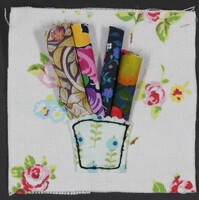 Patch by Emma
A basket of fabrics: fabrics, in particular colourful florals inspire me to sew. The basket holds an assortment of scraps from my dressmaking projects that inspired me to sew something lovely with them - mainly dresses and skirts.
Patch by Emma
A basket of fabrics: fabrics, in particular colourful florals inspire me to sew. The basket holds an assortment of scraps from my dressmaking projects that inspired me to sew something lovely with them - mainly dresses and skirts. -
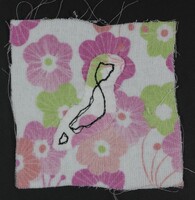 Patch by Emma
Japan: a creative person who inspires me to sew. @meddlesome_penguin who travelled to Japan and brought me back this beautiful fabric from her shopping trips there. I used the fabric and a map of Japan to represent her love of Japanese culture.
Patch by Emma
Japan: a creative person who inspires me to sew. @meddlesome_penguin who travelled to Japan and brought me back this beautiful fabric from her shopping trips there. I used the fabric and a map of Japan to represent her love of Japanese culture. -
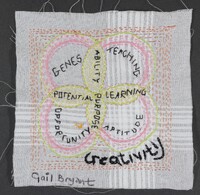 Patch by Gail
My Creative Identity I have made a patch showing a Venn diagram of what I consider has led to me being creative. Did I know I was creative? No. I just do what I can do, what women do. What challenges me and gives gives me pleasure to do, and do well. A label of creative lifts it from Craft to Art giving it credibility. Genes A Paternal Great grandfather a tailor, sitting crossed legged to stitch suits . A Paternal Grandfather an overseer in a mill weaving worsted fabric. A Mother who taught me to knit and sew, I can’t even remember learning it was so long ago. Teaching School needle work, City and Guild embroidery. Devon Weavers Workshop and Sue Dwyer teaching me to weave. Bradford College and a textile design course. Aptitude Able to sit quietly and practice and learn and improve. Opportunity Being in the right place at the right time to see and take advantage of the opportunities, which actually came later than I would have liked. - Patience. Good friends and mentors who have encouraged me.
Patch by Gail
My Creative Identity I have made a patch showing a Venn diagram of what I consider has led to me being creative. Did I know I was creative? No. I just do what I can do, what women do. What challenges me and gives gives me pleasure to do, and do well. A label of creative lifts it from Craft to Art giving it credibility. Genes A Paternal Great grandfather a tailor, sitting crossed legged to stitch suits . A Paternal Grandfather an overseer in a mill weaving worsted fabric. A Mother who taught me to knit and sew, I can’t even remember learning it was so long ago. Teaching School needle work, City and Guild embroidery. Devon Weavers Workshop and Sue Dwyer teaching me to weave. Bradford College and a textile design course. Aptitude Able to sit quietly and practice and learn and improve. Opportunity Being in the right place at the right time to see and take advantage of the opportunities, which actually came later than I would have liked. - Patience. Good friends and mentors who have encouraged me. -
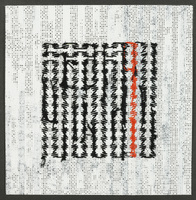 Patch by Hilary
This is a piece of needlepoint. Only the canvas has been saturated in paint and the stitching is dense, dark and not at all pretty. It’s an object and no longer a material and somehow that feels important when it comes to being taken seriously. Maybe it’ll be too much of an object to stitch into? These were my initial thoughts about my sample for this project. I needed to transform the raw materials of an easily recognised ‘women’s craft’ (stranded cotton embroidered onto needlepoint canvas with a needle) into something that would fool the viewer into thinking it was worthy of being taken seriously, as an art object at least. Stitching into the canvas was tough, but satisfying and eventually yielded results. It felt like a metaphor for the struggle to be taken seriously in a judgemental world. I do hope it can be sewn into though!
Patch by Hilary
This is a piece of needlepoint. Only the canvas has been saturated in paint and the stitching is dense, dark and not at all pretty. It’s an object and no longer a material and somehow that feels important when it comes to being taken seriously. Maybe it’ll be too much of an object to stitch into? These were my initial thoughts about my sample for this project. I needed to transform the raw materials of an easily recognised ‘women’s craft’ (stranded cotton embroidered onto needlepoint canvas with a needle) into something that would fool the viewer into thinking it was worthy of being taken seriously, as an art object at least. Stitching into the canvas was tough, but satisfying and eventually yielded results. It felt like a metaphor for the struggle to be taken seriously in a judgemental world. I do hope it can be sewn into though! -
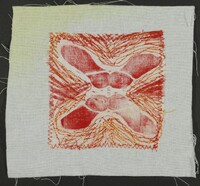 Patch by Jannie
My patch explores the idea of women sowing seeds to create. All life comes from seeds and there are women worldwide who create gardens to feed, nourish and sustain families and in doing so create beauty and new life. The sycamore seed is persistent, tenacious and travels with the wind to populate new corners. I have used it as a symbol of strength and creativity.
Patch by Jannie
My patch explores the idea of women sowing seeds to create. All life comes from seeds and there are women worldwide who create gardens to feed, nourish and sustain families and in doing so create beauty and new life. The sycamore seed is persistent, tenacious and travels with the wind to populate new corners. I have used it as a symbol of strength and creativity. -
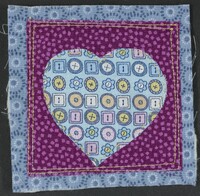 Patch by Lorna
After life changing injuries in 2000, I decided to join a local quilting group. Ladies have encouraged and supported me to learn new skills. The contribution they have made to my rehabilitation has been so much more than any medical experience.
Patch by Lorna
After life changing injuries in 2000, I decided to join a local quilting group. Ladies have encouraged and supported me to learn new skills. The contribution they have made to my rehabilitation has been so much more than any medical experience. -
 Patch by Lorna
After life changing injuries in 2000, I decided to join a local quilting group. Ladies have encouraged and supported me to learn new skills. The contribution they have made to my rehabilitation has been so much more than any medical experience.
Patch by Lorna
After life changing injuries in 2000, I decided to join a local quilting group. Ladies have encouraged and supported me to learn new skills. The contribution they have made to my rehabilitation has been so much more than any medical experience. -
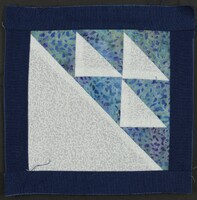 Patch by Mandy
This patch was inspired by a book called The Lost Quilter by Jennifer Chiaverini about a slave, Joanna, who keeps trying to escape from the cruelty of her masters. She manages to hoard some fabric scraps and make a quilt called Birds in the Air, which is made up of blocks of flying geese patterns. When hung up on outside verandas the triangles face north, the direction in which runaway slaves must go in order to reach the states where slavery has been abolished. It is not a true story but certainly contains a lot of factual material - Joanna is passed from one master to another, and during one escape has to leave her son behind (born as a result of rape from one of her masters). I was very moved by the courage and strength shown which must have been true for hundreds of slaves during this terrible time.
Patch by Mandy
This patch was inspired by a book called The Lost Quilter by Jennifer Chiaverini about a slave, Joanna, who keeps trying to escape from the cruelty of her masters. She manages to hoard some fabric scraps and make a quilt called Birds in the Air, which is made up of blocks of flying geese patterns. When hung up on outside verandas the triangles face north, the direction in which runaway slaves must go in order to reach the states where slavery has been abolished. It is not a true story but certainly contains a lot of factual material - Joanna is passed from one master to another, and during one escape has to leave her son behind (born as a result of rape from one of her masters). I was very moved by the courage and strength shown which must have been true for hundreds of slaves during this terrible time. -
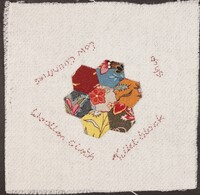 Patch by Rachel
I have been a patchworker since late 1970's. A member of the Quilters Guild of the British Isles I have been a trustee of the Guild and also am a former chair of The British Quilt Study Group. My love of patchwork, its colours and shape of the different blocks and forms has, with my interest in the history of patchwork, merged with the social history attached to the making of quilts, garments and other items from fabric both recycled and new. I am fascinated by the difference in quilts over the years from the iconic 1718 quilt, the oldest dated quilt known in this country, with its intricate blocks and silk fabrics to the quilts depicted in Walter Langley's pictures showing Newlyn fisher girls with basic quilts made from salvaged fabric. so often the maker and the story of her life are unknown but then a letter or diary or family history will reveal information about the probable maker and we can reflect on how she obtained her fabrics, where her inspiration for both the pattern and quilt design came from and the conditions under which the quilt was made. Living in a former port town I have taken elements of the trade to make my patch. The background woollen cloth signifying the huge trade from the area of undyed woollen cloth shipped mainly to the Low Countries from Devon and parts of Somerset, the hexagon patch is the block particularly associated with English paper piecing and the patches have been made using fabric printed in historic Dutch patterns and colours.
Patch by Rachel
I have been a patchworker since late 1970's. A member of the Quilters Guild of the British Isles I have been a trustee of the Guild and also am a former chair of The British Quilt Study Group. My love of patchwork, its colours and shape of the different blocks and forms has, with my interest in the history of patchwork, merged with the social history attached to the making of quilts, garments and other items from fabric both recycled and new. I am fascinated by the difference in quilts over the years from the iconic 1718 quilt, the oldest dated quilt known in this country, with its intricate blocks and silk fabrics to the quilts depicted in Walter Langley's pictures showing Newlyn fisher girls with basic quilts made from salvaged fabric. so often the maker and the story of her life are unknown but then a letter or diary or family history will reveal information about the probable maker and we can reflect on how she obtained her fabrics, where her inspiration for both the pattern and quilt design came from and the conditions under which the quilt was made. Living in a former port town I have taken elements of the trade to make my patch. The background woollen cloth signifying the huge trade from the area of undyed woollen cloth shipped mainly to the Low Countries from Devon and parts of Somerset, the hexagon patch is the block particularly associated with English paper piecing and the patches have been made using fabric printed in historic Dutch patterns and colours. -
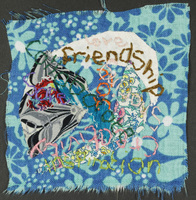 Patch by Sim
Patchwork Pals is an informal group of five older women linked by a connection that they all worked together at a Further Education College. We come together regularly in each other’s homes to discuss, crafting and art; projects we are working on; to share ideas; and collaborate. We admire and touch each other’s art works and creations. We have a What’s App group where we share inspiring images and details for exhibitions for PP trips. The patchwork is made from a scrap of textile contributed from each woman including vintage scraps from our teenage years! The image is a swirl to represent interconnectedness. I have embroidered words that we considered represented PP. I imagine the words as a Wordle or word cloud of our creative energies. Conversations at PP gatherings are often animated and always fun with cakes and tea. Friendship for life’s challenge, celebrations and grief.
Patch by Sim
Patchwork Pals is an informal group of five older women linked by a connection that they all worked together at a Further Education College. We come together regularly in each other’s homes to discuss, crafting and art; projects we are working on; to share ideas; and collaborate. We admire and touch each other’s art works and creations. We have a What’s App group where we share inspiring images and details for exhibitions for PP trips. The patchwork is made from a scrap of textile contributed from each woman including vintage scraps from our teenage years! The image is a swirl to represent interconnectedness. I have embroidered words that we considered represented PP. I imagine the words as a Wordle or word cloud of our creative energies. Conversations at PP gatherings are often animated and always fun with cakes and tea. Friendship for life’s challenge, celebrations and grief. -
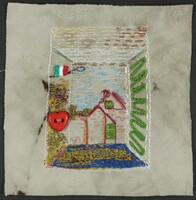 Patch by Susan
A Room with a View. It seemed appropriate for me to stitch my own view of a coffee shop window in Cortona, Tuscany, Italy where I regularly visit when I am staying there, for this Art of Fiction project. I love going to Italy and enjoy the colours, landscapes, and architecture together with the way of life. The fabric is natural hand dyed cotton with machine stitching as an outline - a new method for me, and hand stitching, my preferred way of working, to bring out the detail. The button is from an outfit I wore as a teenager in the 1970's - a time that I first visited Italy and now in my 60's I have a home there to enjoy. Lucky me!
Patch by Susan
A Room with a View. It seemed appropriate for me to stitch my own view of a coffee shop window in Cortona, Tuscany, Italy where I regularly visit when I am staying there, for this Art of Fiction project. I love going to Italy and enjoy the colours, landscapes, and architecture together with the way of life. The fabric is natural hand dyed cotton with machine stitching as an outline - a new method for me, and hand stitching, my preferred way of working, to bring out the detail. The button is from an outfit I wore as a teenager in the 1970's - a time that I first visited Italy and now in my 60's I have a home there to enjoy. Lucky me!